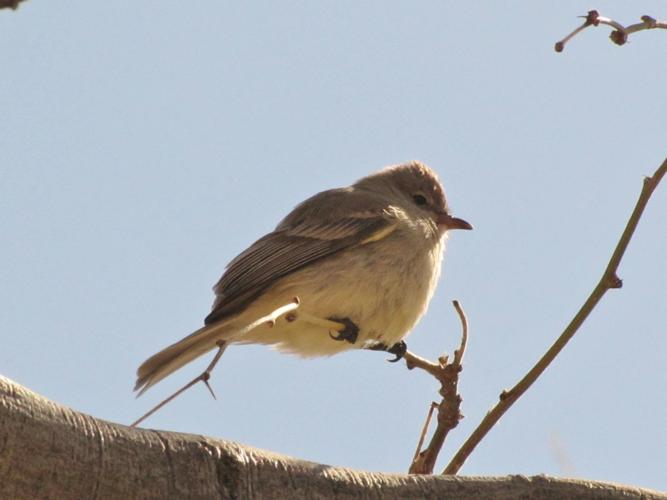So far, we have documented 146 species of birds in SaddleBrooke. One of the most secretive and interesting of these is a lightweight not much larger than a hummingbird, but with more syllables in his name than any of our other 145 species. This is the Northern Beardless-Tyrannulet, a name that is as unusual and strange as it is long. In case you are wondering, there is a Southern Beardless-Tyrannulet, as well, but you’ll have to go to Costa Rica to find him. If you are a birder, the Northern Beardless-Tyrannulet is just one more reason to live in southeastern Arizona. Common from Mexico to Costa Rica, this tyrannulet is found only in the most southern part of Texas, southwestern New Mexico and southeastern Arizona in the U.S. A member of the large tyrant flycatcher family, which includes such familiar birds as the Ash-throated Flycatcher, Vermilion Flycatcher, and Say’s Phoebe, the Northern Beardless-Tyrannulet looks and behaves much more like a Verdin, Ruby-crowned Kinglet, or Bell’s Vireo.
Our other tyrant flycatchers hunt insects from exposed perches, like tree limbs (Ash-throated Flycatcher), power lines (Western Kingbird), or posts (Vermilion Flycatcher), but not the tyrannulet, which is one reason he is so seldom seen. Instead, the Northern Beardless-Tyrannulet feeds inside bushes and trees, hopping and foraging along branches, gleaning insects acrobatically in the fashion of kinglets, vireos, and Verdins. Easily mistaken for these other gleaners, the tyrannulet is often overlooked or missed altogether by birders. In addition to his secretive behavior, the tyrannulet is not a common bird around here, making it even harder to find him. Tyrannulets nest in southeastern Arizona, including parts of Pinal County, and observations have been recorded in every month of the year, suggesting that some of the population do not return to Mexico in the winter. Most do, however, returning to Arizona in March and then departing again by September.
The most likely nearby place to find a tyrannulet is Catalina State Park, but we have also seen them in SaddleBrooke. During a frosty morning walk along a golf cart path this past February, we had seen a few Verdins and a Ruby-crowned Kinglet foraging in the leafless mesquites. As we neared Ridgeview, we saw another small bird hopping around a bare-branched mesquite ahead. We assumed this was another kinglet or Verdin, but as we drew nearer we could see that the tiny bird had a flycatcher-like crest, no yellow head (like a Verdin) and no eye ring (like a kinglet). This was our first discovery of a Northern Beardless-Tyrannulet in SaddleBrooke, and we forgot the cold as we enjoyed this little bird’s acrobatic hunting just ten feet away. Unfortunately, I had forgotten the camera. We assumed this was a passing bit of luck, but 12 days later we repeated the walk and found the tyrannulet in the same tree. This time, I brought the camera, and photos in this article were taken that day.
But, you may be asking, what about that ‘beardless’ part of the name? Almost all tyrant flycatchers have stiff bristles around their bills, which is as close to a ‘beard’ as you’re going to find in a bird. Our tyrannulet has none of these, and consequently is called ‘beardless’. Since the other tyrant flycatchers catch insects in flight, rather than picking them off branches, at one time it was believed that these rictal bristles existed to help channel insects into the flying birds’ mouths. However, laboratory experiments that taped down or clipped off the bristles found that the birds were unimpaired in catching insects. Hopefully, the genius that came up with that experiment suffered a similar ordeal. Another rictal bristle theory is that they somehow protect flycatcher eyes from high-speed aerial collisions with insects. Fortunately, as far as I know, this has not yet been tested.
If you have questions or comments about SaddleBrooke’s birds, or to receive emailed information about bird walks led by Bob and Prudy, call 825-9895 or email bobandpru@aol.com. Previously published articles can be found at www.birdingthebrookeandbeyond.com.








